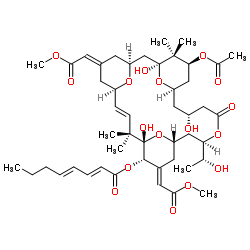Bryostatin 1

Bryostatin 1 structure
|
Common Name | Bryostatin 1 | ||
|---|---|---|---|---|
| CAS Number | 83314-01-6 | Molecular Weight | 905.033 | |
| Density | 1.3±0.1 g/cm3 | Boiling Point | 954.7±65.0 °C at 760 mmHg | |
| Molecular Formula | C47H68O17 | Melting Point | N/A | |
| MSDS | Chinese USA | Flash Point | 270.0±27.8 °C | |
|
Bryostatin-1 promotes long-term potentiation via activation of PKCα and PKCε in the hippocampus.
Neuroscience 226 , 348-55, (2012) Activation of protein kinase C (PKC) by bryostatin-1 affects various functions of the central nervous system. We explored whether bryostatin-1 influenced synaptic plasticity via a process involving PKC. Our purpose was to examine whether bryostatin-1 affected... |
|
|
Bryostatin-I: A dendritic cell stimulator for chemokines induction and a promising adjuvant for a peptide based cancer vaccine
Cytokine 52(3) , 238-44, (2010) Bryostatin-1 (Bryo-1), a PKC modulator, was previously shown to activate monocytes and lymphocytes to produce cytokines. In this report, we investigated the adjuvanticity of Bryo-1 both in vitro and in vivo. First, Bryo-1 was found to induce the release of CC... |
|
|
Differentiation therapy in poor risk myeloid malignancies: Results of a dose finding study of the combination bryostatin-1 and GM-CSF.
Leuk. Res. 35(1) , 87-94, (2011) Pharmacologic differentiating agents have had relatively limited clinical success outside of the use of ATRA in acute promyelocytic leukemia and DNA methyltransferase inhibitors in myelodysplastic syndromes. The differentiating effects of such agents can be e... |
|
|
Enhancement of HLA class II-restricted CD4+ T cell recognition of human melanoma cells following treatment with bryostatin-1.
Cell. Immunol. 271(2) , 392-400, (2011) The majority of melanoma cells express detectable levels of HLA class II proteins, and an increased threshold of cell surface class II is crucial for the stimulation of CD4+ T cells. Bryostatin-1, a protein kinase C (PKC) activator, has been considered as a p... |
|
|
HLA class II defects in Burkitt lymphoma: bryostatin-1-induced 17 kDa protein restores CD4+ T-cell recognition.
Clin. Dev. Immunol. 2011 , 780839, (2011) While the defects in HLA class I-mediated Ag presentation by Burkitt lymphoma (BL) have been well documented, CD4+ T-cells are also poorly stimulated by HLA class II Ag presentation, and the reasons underlying this defect(s) have not yet been fully resolved. ... |
|
|
Phase II trial of bryostatin-1 in combination with cisplatin in patients with recurrent or persistent epithelial ovarian cancer: a California cancer consortium study.
Invest. New Drugs 30(2) , 723-8, (2012) The California Cancer Consortium has performed a Phase II trial of infusional bryostatin, a protein kinase C inhibitor isolated from the marine invertebrate bryozoan, Bugula Neritina, a member of the phylum Ectoprocta, in combination with cisplatin, in patien... |
|
|
The cytotoxicity of anti-CD22 immunotoxin is enhanced by bryostatin 1 in B-cell lymphomas through CD22 upregulation and PKC-βII depletion.
Haematologica 97(5) , 771-9, (2012) In spite of potent first-line therapies for chronic lymphocytic leukemia, treatment remains palliative and all patients frequently relapse. Treatment options for these patients are more limited. BL22 is a recombinant protein composed of the variable region of... |
|
|
Bryostatin-1, a naturally occurring antineoplastic agent, acts as a Toll-like receptor 4 (TLR-4) ligand and induces unique cytokines and chemokines in dendritic cells.
J. Biol. Chem. 286(1) , 24-34, (2011) Bryostatin-1 (Bryo-1), a natural macrocyclic lactone, is clinically used as an anti-cancer agent. In this study, we demonstrate for the first time that Bryo-1 acts as a Toll-like receptor 4 (TLR4) ligand. Interestingly, activation of bone marrow-derived dendr... |
|
|
Total synthesis of bryostatin 1: a short route.
Angew. Chem. Int. Ed. Engl. 50(38) , 8786-9, (2011)
|
|
|
Improved protein kinase C affinity through final step diversification of a simplified salicylate-derived bryostatin analog scaffold.
Org. Lett. 16(19) , 5140-3, (2014) Bryostatin 1, in clinical trials or preclinical development for cancer, Alzheimer's disease, and a first-of-its-kind strategy for HIV/AIDS eradication, is neither readily available nor optimally suited for clinical use. In preceding work, we disclosed a new c... |